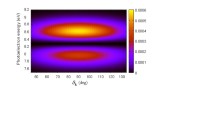Abstract
A theory for the response of a 2D two-level system to irradiation by a symmetric light pulse is developed. Under certain conditions, such an electron system approximates an ideal solitary quantum well in a zero field or a strong magnetic field H perpendicular to the plane of the well. One of the energy levels is the ground state of the system, while the other is a discrete excited state with energy ℏω0, which may be an exciton level for H=0 or any level in a strong magnetic field. It is assumed that the effect of other energy levels and the interaction of light with the lattice can be ignored. General formulas are derived for the time dependence of the dimensionless “coefficients” of the reflection ℛ(t), absorption A(t), and transmission ℐ(t) for a symmetric light pulse. It is shown that the ℛ(t), A(t), and ℐ(t) time dependences have singular points of three types. At points t 0 of the first type, A(t 0)=T(t 0)=0 and total reflection takes place. It is shown that for γr≫γ, where γr and γ are the radiative and nonradiative reciprocal lifetimes, respectively, for the upper energy level of the two-level system, the amplitude and shape of the transmitted pulse can change significantly under the resonance ωl=ω0. In the case of a long pulse, when γl<γr, the pulse is reflected almost completely. (The quantity γl characterizes the duration of the exciting pulse.) In the case of an intermediate pulse duration γl≅γr, the reflection, absorption, and transmission are comparable in value and the shape of the transmitted pulse differs considerably from the shape of the exciting pulse: the transmitted pulse has two peaks due to the existence of the point t 0 of total reflection, at which the transmission is zero. If the carrier frequency ωl of light differs from the resonance frequency ω0, the oscillating ℛ(t), A(t), and ℐ(t) time dependences are observed at the frequency Δω=ωl−ω0. Oscillations can be observed most conveniently for Δω≅γl. The position of the singular points of total absorption, reflection, and transparency is studied for the case when ωl differs from the resonance frequency.
Similar content being viewed by others
References
I. G. Lang and V. I. Belitsky, Solid State Commun. 107(10), 577 (1998).
L. C. Andreani, F. Tassone, and F. Bassani, Solid State Commun. 77(9), 641 (1991).
L. C. Andreani, in Confined Electrons and Photons, Ed. by E. Burstein and C. Weisbuch (Plenum, New York, 1995), p. 57.
E. L. Ivchenko, Fiz. Tverd. Tela (Leningrad) 33(8), 2388 (1991) [Sov. Phys. Solid State 33, 1344 (1991)].
F. Tassone, F. Bassani, and L. C. Andreani, Phys. Rev. B 45(11), 6023 (1992).
T. Strouken, A. Knorr, C. Anthony, et al., Phys. Rev. Lett. 74(9), 2391 (1995).
T. Strouken, A. Knorr, P. Thomas, and S. W. Koch, Phys. Rev. B 53(4), 2026 (1996).
L. C. Andreani, G. Panzarini, A. V. Kavokin, and M. V. Vladimirova, Phys. Rev. B 57(8), 4670 (1998).
M. Hübner, J. Kuhl, S. Haas, et al., Solid State Commun. 105(2), 105 (1998).
I. G. Lang, V. I. Belitsky, and M. Gardona, Phys. Status Solidi A 164(1), 307 (1997).
I. G. Lang and V. I. Belitsky, Phys. Lett. A 245(4), 329 (1998).
I. G. Lang, L. I. Korovin, D. A. Contreras-Solorio, and S. T. Pavlov, cond-mat/0001248; Phys. Rev. B (in press).
D. A. Contreras-Solorio, S. T. Pavlov, L. I. Korovin, and I. G. Lang, cond-mat/0002229; Phys. Rev. B (in press).
I. G. Lang, L. I. Korovin, D. A. Contreras-Solorio, and S. T. Pavlov, cond-mat/0004178.
H. Stolz, Time Resolved Light Scattering from Excitons (Springer-Verlag, Berlin, 1994).
L. I. Korovin, I. G. Lang, and S. T. Pavlov, Zh. Éksp. Teor. Fiz. 116, 1419 (1999) [JETP 89, 764 (1999)].
Author information
Authors and Affiliations
Additional information
__________
Translated from Fizika Tverdogo Tela, Vol. 42, No. 12, 2000, pp. 2230–2244.
Original Russian Text Copyright © 2000 by Korovin, Lang, Contreras-Solorio, Pavlov.
Rights and permissions
About this article
Cite this article
Korovin, L.I., Lang, I.G., Contreras-Solorio, D.A. et al. Change in the shape of a symmetric light pulse passing through a quantum well. Phys. Solid State 42, 2300–2313 (2000). https://doi.org/10.1134/1.1332155
Received:
Issue Date:
DOI: https://doi.org/10.1134/1.1332155



